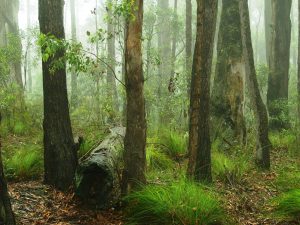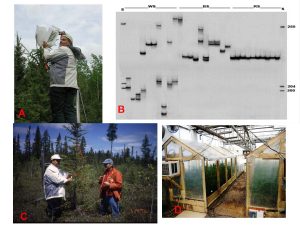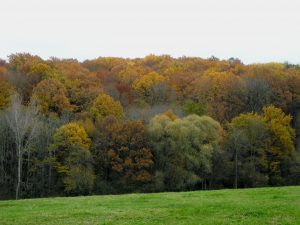IUFRO Spotlight #57 – Transition in forest uses demands change in approaches

Wood chips being transported to a pulp mill. These chips represent the waste stream from a saw mill, but are becoming increasingly valuable as more and more uses for wood are developed. Photo by John Innes.
“The portfolio of goods and services from forests is now very different to that two decades ago; yet there is a disconnect between the institutional framework and these new forms of forest use, leading to efficiency, equity and legitimacy deficits,” said Dr. John Innes, Dean of the Faculty of Forestry at the University of British Columbia, Canada.
The changes – from forest planting and forest harvesting and operations, to forest use and forest products – occur at different levels. Today, forests produce a complex array of products from forest ecosystem services to timber and bio-products.
Market values are increasingly being attached to forest ecosystem services and this is changing the value systems associated with forestry. Read more…
IUFRO 125th Anniversary Congress Spotlight #56 – Environment vs. economy: Mapping the forest environmental frontier
To some, the forests mean combatting illegal logging and associated trade, avoiding deforestation and degradation, conserving biodiversity and protecting wilderness.

Photo by Geoff Roberts, Australia
To others, the forests mean timber as a renewable raw material for uses such as construction and bioenergy, forest-based climate change adaptation and mitigation and transitioning toward a forest-based bioeconomy.
“These issues can be termed the global forest environmental frontier,” said Dr. Georg Winkel, Head of the European Forest Institute’s Resilience Research Programme in Bonn, Germany.
“All the issues are interrelated and relate to a global controversy that asks how we can keep and manage the world’s forests to satisfy both ecological and socio-economic needs now and in the future,” he said.
Dr. Winkel is coordinator of a session entitled The Global Forest Environmental Frontier – What has changed, what has remained unchanged, how will the future look? at the IUFRO 125th Anniversary Congress in Freiburg, Germany in September. Read more…
IUFRO 125th Anniversary Congress Spotlight #55: Genetics research crucial to future forest health, adaptation, conservation and sustainable management
“The role genetics/genomics research can play in forest management is huge but, unfortunately, remains under-utilized,” said Dr. Om Rajora, Professor of Forest Genetics and Genomics at the University of New Brunswick, Canada.

A. Controlled pollination in black spruce to produce F3 progeny at Petawawa Research Forest; B. DNA fingerprints of 10 individuals each of white spruce (WS), black spruce (BS) and red spruce (RS) at a genic microsatellite showing genetic diversity; C. Sampling of old-growth and post-harvest second-growth black spruce to examine the genetic effects of forest harvesting and renewal practices in Manitoba (Rajora and Pluhar 2003, Theor. Appl. Genet. 106: 1203-1212); D. Testing of three-generation outbred pedigree of black spruce under ambient and elevated CO2 conditions for QTL mapping of traits related to acclimation and adaptation to climate change. All pictures were taken by Dr. Om Rajora or his associates.
“Genetics/genomics research can greatly assist the management of natural and planted forests by conserving healthy, productive, well-adapted and genetically diverse natural forest and developing high yielding tree varieties with desired traits for deployment in plantations,” he said.
Dr. Rajora is the organizer and coordinator of a session entitled Genetics and Genomics for Conservation, Climate Adaptation and Sustainable Management of Forests to be presented at the IUFRO 125th Anniversary Congress in Freiburg, Germany in September. Read more…
IUFRO Spotlight #54 – Variety could be the spice of life – for forests

Autumn leaves in a mixed-species forest of France. Photo by Damien Bonal, one of the co-authors of the review.
An increasing number of studies demonstrate that mixed forests can deliver many ecosystem services at a higher level than pure forests.
Today, however, less than 0.1% of plantation forests worldwide are made of mixed tree species. And, by the end of this century there is the potential for about 20% of the world’s forest area to be represented by planted forests.
“More efforts should be made to develop new mixed, planted forests,” said Dr. Hervé Jactel of the French National Institute for Agricultural Research. He is one of the authors of a new review, Tree Diversity Drives Forest Stand Resistance to Natural Disturbances, which reviews the relationships between tree diversity and stand resistance to natural disturbances, and explores the ecological mechanisms behind the observed relationships. Read more…
IUFRO 125th Anniversary Congress Spotlight #53 – Humans and Wildlife: Sharing Space in a Crowded World
There’s a line in a song by U.S. singer-songwriter Dee Moeller that goes: “The wide open spaces are closing in quickly, from the weight of the whole human race…”

Elephant dung found on a village farm, with crop damage, nearby Pendjari Biosphere Reserve (Northern Benin). Credit Dr Chabi DJAGOUN
That line could well be the sub-title for a session to be held at the upcoming IUFRO 125th Congress in Freiburg, Germany entitled: Co-existence of humans and wildlife in changing landscapes and climate.
Current human population growth is causing an increasing demand for natural resources and a growing pressure for access to land which, among other things, affects wildlife habitat and the interactions between wildlife and humans, said Dr. Chabi Djagoun, of the Laboratory of Applied Ecology in Cotonou, Benin. Read more…
